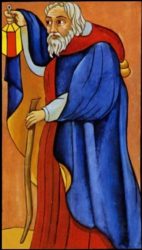We never start from the “many”, but from the “One” in a state of privation which is correlative to the appearance of others around and against it, in order to move to the “One” in a state of fullness and sufficiency, in which such an appearance is consummated.
~ Julius Evola
To understand the creation of the world, we need to begin with the concept of privation. “Privation” is the absence of a given form in something capable of possessing it. As it is a lack, it has no being in itself, yet it is part of experience. Whatever appears to limit me, whatever seems to oppose my Will, reveals an insufficiency in me, that is, a “privation”. Rather than simply representing a lack or insufficiency, a being may embrace privation and deliberately choose to limit itself. Boris Mouravieff writes (Gnosis, Vol 1):
Orthodox Tradition teaches that the Universe was created by a sacrifice of God. We shall understand this postulate better if we consider that it differentiates between the state of manifested Divinity and that of unmanifested Divinity — which is therefore limitless and free from all conditions. God’s sacrifice is Self-limitation by manifestation.
By this withdrawal, the unmanifested God, the Universal I, creates a space for the Other selves. The relationship is sustained through Love. Mouravieff explains:
To pass or cross from the non-manifested state — a monopolar one, concentrated on the unique consciousness of Self within which the Divinity remains before the Creation of the World — the first Idea which makes the Divinity come out of the state of non-manifestation to become manifest, is necessarily that of the You. This idea, conceived by the divine sacrifice of Self-limitation, has Love, a neutralizing force, or third force.
We can understand this Hermetically. Mouravieff is describing the Macrocosm, which through a consciously willed privation, creates the Other and binds the relationship with love. Man, the microcosm, on the other hand, wills privation, or the Other, spontaneously without conscious choice. Hence, Trials are necessary. In the Trial by Suffering, Man endures the privation in the understanding it is the product of his own will and consciousness. In the Trial by Love, Man neutralizes the privation by Love, ending the opposition.
In Meditations on the Tarot, Valentin Tomberg takes up the same theme. He makes clear that the withdrawal is real, in the sense that Man has a real, noumenal, free existence, not just an apparent, phenomenal one as in pantheistic systems. Tomberg draws on the Cabbalist doctrine of tsimtsum to make the point:
The first act of En-Soph, the Infinite Being, is therefore not a step outside but a step inside, a movement of recoil, of falling back upon oneself, of withdrawing into oneself. Instead of emanation we have the opposite, contraction…The first act of all is not an act of revelation but one of limitation. Only in the second act does God send out a ray of His light and begin His revelation, or rather His unfolding as God the Creator, in the primordial space of his own creation. More than that, every new act of emanation and manifestation is preceded by one of concentration and retraction.
Scholem, Major Trends in Jewish Mysticism
Tomberg goes on to clarify:
In other words, in order to create the world ex nihilo, God had first to bring the void itself into existence. He had to withdraw within in order to create a mystical space, a space without his presence — the void. And it is in thinking this thought that we are present at the birth of freedom.
A note of clarification is necessary, since Tomberg writes as a cosmologist, not a metaphysician. The void as such can never exist, or be created. Instead, the idea of the void is the ontological space where beings, as possibilities of manifestation, come into existence. The void is freedom, it is the source of creativity. Tomberg summarizes:
The void — the mystical space from which God withdrew himself through his act of tsimtsum — is the place of origin of freedom, i.e., the place of the origin of an ex-istence which is absolute potentiatlily, not in any way determined… These two indestructible elements—the meonic element (“me on”=void) and the pleromic element (plenitude) are indissolubly bound to one another.

My reading of what Tomberg says in that the void is created is that it is not God, i.e. God is not Void or Emptiness, rather even the Void or meonic element is conceived by God, it is an act of Tzimtzum/Kenosis to allow something to be.
Yes, there is a subtle distinction: the void, as you point out, “allows something to be”. Hence, the void itself cannot “be”. It can’t be envisioned as a sort of “space” into which beings are placed, since it is ontologically prior to space and time. Therfore, the meonic and pleromic are “simultaneous”, though we cannot even speak in terms of time.
Compare to Nature Abhors a Vacuum.
Thank you for saying that the meonic and pleromic elements are simultaneous! This has been an intuition on the edge of my consciousness for some time.
Nicely put! “intuition on the edge of my consciousness“. That is the only way to understand such things.
It is said the cosmos was created from within this tiny point,
within the All-God-ness,
the Pleroma perhaps
or Ayn Sof
God withdrew His All-ness
from this tiny point
then into this tiny point
He shined the Light
of the first letter of His
Name…Yod
from this scintillating
all would emerge
great post.
great website
thanks.
Edwin Israel Shendelman